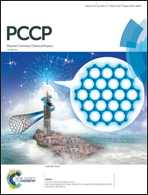TMAO and urea in the hydration shell of the protein SNase
Abstract
We performed all-atom MD simulations of the protein SNase in aqueous solution and in the presence of two major osmolytes, trimethylamine-N-oxide (TMAO) and urea, as cosolvents at various concentrations and compositions and at different pressures and temperatures. The distributions of the cosolvent molecules and their orientation in the surroundings of the protein were analyzed in great detail. The distribution of urea is largely conserved near the protein. It varies little with pressure and temperature, and does practically not depend on the addition of TMAO. The slight decrease with temperature of the number of urea molecules that are in contact with the SNase molecule is consistent with the view that the interaction of the protein with urea is mainly of enthalpic nature. Most of the TMAO molecules tend to be oriented to the protein by its methyl groups, a small amount of these molecules contact the protein by its oxygen, forming hydrogen bonds with the protein, only. Unlike urea, the fraction of TMAO in the hydration shell of SNase slightly increases with temperature (a signature of a prevailing hydrophobic interaction between TMAO and SNase), and decreases significantly upon the addition of urea. This behavior reflects the diverse nature of the interaction of the two osmolytes with the protein. Using the Voronoi volume of the atoms of the solvent molecules (water, urea, TMAO), we compared the fraction of the volume occupied by a given type of solvent molecule in the hydration shell and in the bulk solvent. The volume fraction of urea in the hydration shell is more than two times larger than in the bulk, whereas the volume fraction of TMAO in the hydration shell is only slightly larger in the binary solvent (TMAO + water) and becomes even less than in the bulk in the ternary solvent (TMAO + water + urea). Thus, TMAO tends to be excluded from the hydration shell of the protein. The behavior of the two cosolvents in the vicinity of the protein does not change much with pressure (from 1 to 5000 bar) and temperature (from 280 to 330 K). This is also in line with the conception of the “osmophobic effect” of TMAO to protect proteins from denaturation also at harsh environmental conditions. We also calculated the volumetric parameters of SNase and found that the cosolvents have a small but significant effect on the apparent volume and its contributions, i.e. the intrinsic, molecular and thermal volumes.



 Please wait while we load your content...
Please wait while we load your content...